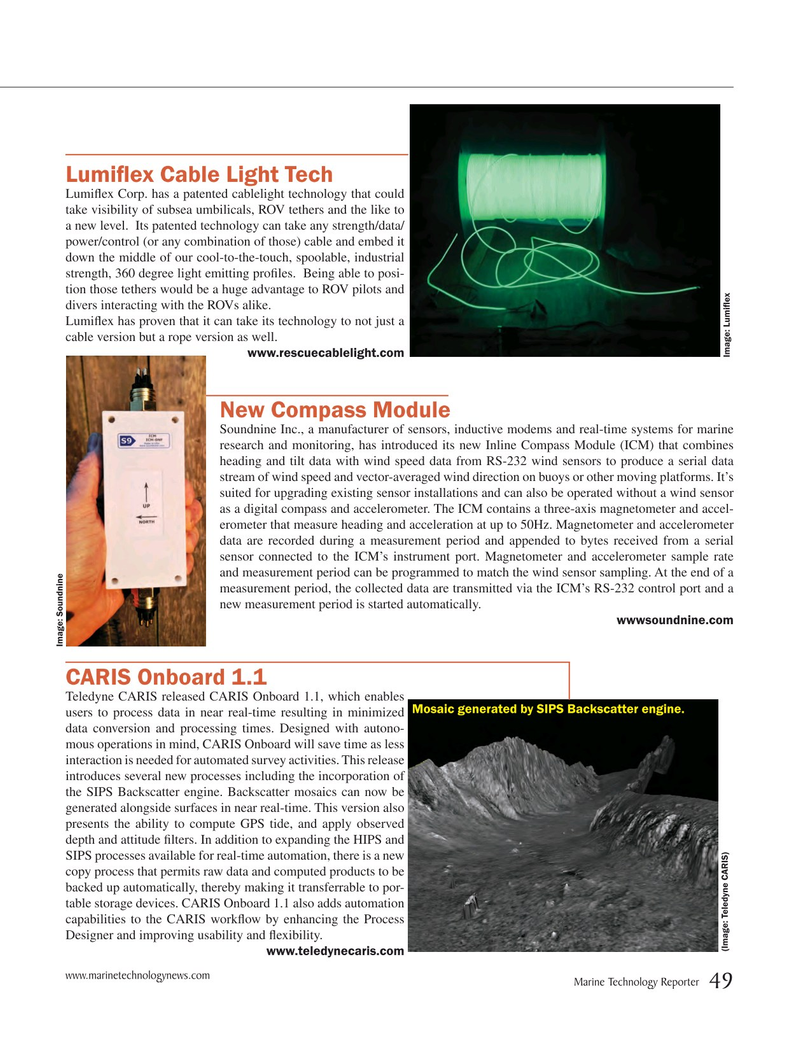
Page 49: of Marine Technology Magazine (January 2017)
Underwater Vehicle Annual: ROV, AUV, and UUVs
Read this page in Pdf, Flash or Html5 edition of January 2017 Marine Technology Magazine
Lumi? ex Cable Light Tech
Lumi? ex Corp. has a patented cablelight technology that could take visibility of subsea umbilicals, ROV tethers and the like to a new level. Its patented technology can take any strength/data/ power/control (or any combination of those) cable and embed it down the middle of our cool-to-the-touch, spoolable, industrial strength, 360 degree light emitting pro? les. Being able to posi- tion those tethers would be a huge advantage to ROV pilots and divers interacting with the ROVs alike.
Lumi? ex has proven that it can take its technology to not just a cable version but a rope version as well. www.rescuecablelight.com
Image: Lumi? ex
New Compass Module
Soundnine Inc., a manufacturer of sensors, inductive modems and real-time systems for marine research and monitoring, has introduced its new Inline Compass Module (ICM) that combines heading and tilt data with wind speed data from RS-232 wind sensors to produce a serial data stream of wind speed and vector-averaged wind direction on buoys or other moving platforms. It’s suited for upgrading existing sensor installations and can also be operated without a wind sensor as a digital compass and accelerometer. The ICM contains a three-axis magnetometer and accel- erometer that measure heading and acceleration at up to 50Hz. Magnetometer and accelerometer data are recorded during a measurement period and appended to bytes received from a serial sensor connected to the ICM’s instrument port. Magnetometer and accelerometer sample rate and measurement period can be programmed to match the wind sensor sampling. At the end of a measurement period, the collected data are transmitted via the ICM’s RS-232 control port and a new measurement period is started automatically. wwwsoundnine.com
Image: Soundnine
CARIS Onboard 1.1
Teledyne CARIS released CARIS Onboard 1.1, which enables Mosaic generated by SIPS Backscatter engine.
users to process data in near real-time resulting in minimized data conversion and processing times. Designed with autono- mous operations in mind, CARIS Onboard will save time as less interaction is needed for automated survey activities. This release introduces several new processes including the incorporation of the SIPS Backscatter engine. Backscatter mosaics can now be generated alongside surfaces in near real-time. This version also presents the ability to compute GPS tide, and apply observed depth and attitude ? lters. In addition to expanding the HIPS and
SIPS processes available for real-time automation, there is a new copy process that permits raw data and computed products to be backed up automatically, thereby making it transferrable to por- table storage devices. CARIS Onboard 1.1 also adds automation capabilities to the CARIS work? ow by enhancing the Process
Designer and improving usability and ? exibility.
(Image: Teledyne CARIS) www.teledynecaris.com www.marinetechnologynews.com
Marine Technology Reporter 49
MTR #1 (34-49).indd 49 MTR #1 (34-49).indd 49 1/24/2017 1:33:19 PM1/24/2017 1:33:19 PM

 48
48

 50
50
